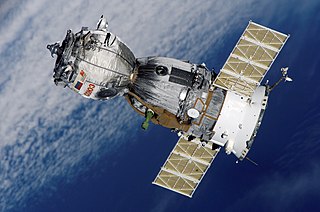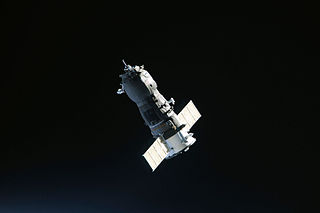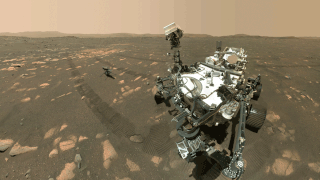Related Research Articles

2001 Mars Odyssey is a robotic spacecraft orbiting the planet Mars. The project was developed by NASA, and contracted out to Lockheed Martin, with an expected cost for the entire mission of US$297 million. Its mission is to use spectrometers and a thermal imager to detect evidence of past or present water and ice, as well as study the planet's geology and radiation environment. It is hoped that the data Odyssey obtains will help answer the question of whether life existed on Mars and create a risk-assessment of the radiation that future astronauts on Mars might experience. It also acts as a relay for communications between the Curiosity rover, and previously the Mars Exploration Rovers and Phoenix lander, to Earth. The mission was named as a tribute to Arthur C. Clarke, evoking the name of his and Stanley Kubrick's 1968 film 2001: A Space Odyssey.

The Mariner program was conducted by the American space agency NASA to explore other planets. Between 1962 and late 1973, NASA’s Jet Propulsion Laboratory (JPL) designed and built 10 robotic interplanetary probes named Mariner to explore the inner Solar System - visiting the planets Venus, Mars and Mercury for the first time, and returning to Venus and Mars for additional close observations.
Mariner 4 was the fourth in a series of spacecraft intended for planetary exploration in a flyby mode. It was designed to conduct closeup scientific observations of Mars and to transmit these observations to Earth. Launched on November 28, 1964, Mariner 4 performed the first successful flyby of the planet Mars, returning the first close-up pictures of the Martian surface. It captured the first images of another planet ever returned from deep space; their depiction of a cratered, dead planet largely changed the scientific community's view of life on Mars. Other mission objectives were to perform field and particle measurements in interplanetary space in the vicinity of Mars and to provide experience in and knowledge of the engineering capabilities for interplanetary flights of long duration. On December 21, 1967, communications with Mariner 4 were terminated.

Space exploration is the use of astronomy and space technology to explore outer space. While the exploration of space is carried out mainly by astronomers with telescopes, its physical exploration though is conducted both by unmanned robotic space probes and human spaceflight. Space exploration, like its classical form astronomy, is one of the main sources for space science.

A spacecraft is a vehicle or machine designed to fly in outer space. A type of artificial satellite, spacecraft are used for a variety of purposes, including communications, Earth observation, meteorology, navigation, space colonization, planetary exploration, and transportation of humans and cargo. All spacecraft except single-stage-to-orbit vehicles cannot get into space on their own, and require a launch vehicle.

A robotic spacecraft is an uncrewed spacecraft, usually under telerobotic control. A robotic spacecraft designed to make scientific research measurements is often called a space probe. Many space missions are more suited to telerobotic rather than crewed operation, due to lower cost and lower risk factors. In addition, some planetary destinations such as Venus or the vicinity of Jupiter are too hostile for human survival, given current technology. Outer planets such as Saturn, Uranus, and Neptune are too distant to reach with current crewed spacecraft technology, so telerobotic probes are the only way to explore them.

Mars Express is a space exploration mission being conducted by the European Space Agency (ESA). The Mars Express mission is exploring the planet Mars, and is the first planetary mission attempted by the agency. "Express" originally referred to the speed and efficiency with which the spacecraft was designed and built. However "Express" also describes the spacecraft's relatively short interplanetary voyage, a result of being launched when the orbits of Earth and Mars brought them closer than they had been in about 60,000 years.

Uncrewed spacecraft or unmanned spacecraft are spacecraft without people on board, used for robotic spaceflight. Uncrewed spacecraft may have varying levels of autonomy from human input; they may be remote controlled, remote guided or even autonomous, meaning they have a pre-programmed list of operations, which they will execute unless otherwise instructed.

A lander is a spacecraft that descends towards, comes to rest on, the surface of an astronomical body. In contrast to an impact probe, which makes a hard landing that damages or destroys the probe upon reaching the surface, a lander makes a soft landing after which the probe remains functional.

The planet Mars has been explored remotely by spacecraft. Probes sent from Earth, beginning in the late 20th century, have yielded a large increase in knowledge about the Martian system, focused primarily on understanding its geology and habitability potential. Engineering interplanetary journeys is complicated and the exploration of Mars has experienced a high failure rate, especially the early attempts. Roughly sixty percent of all spacecraft destined for Mars failed before completing their missions and some failed before their observations could begin. Some missions have met with unexpected success, such as the twin Mars Exploration Rovers, Spirit and Opportunity which operated for years beyond their specification.

Mars Reconnaissance Orbiter (MRO) is a spacecraft designed to study the geology and climate of Mars, provide reconnaissance of future landing sites, and relay data from surface missions back to Earth. It was launched on August 12, 2005 and reached Mars on March 10, 2006. In November 2006, after five months of aerobraking, it entered its final science orbit and began its primary science phase. The cost to develop and operate MRO through the end of its prime mission in 2010 was US$716.6 million.

Dawn is a retired space probe that was launched by NASA in September 2007 with the mission of studying two of the three known protoplanets of the asteroid belt: Vesta and Ceres. In the fulfillment of that mission—the ninth in NASA's Discovery Program—Dawn entered orbit around Vesta on July 16, 2011, and completed a 14-month survey mission before leaving for Ceres in late 2012. It entered orbit around Ceres on March 6, 2015. In 2017, NASA announced that the planned nine-year mission would be extended until the probe's hydrazine fuel supply was depleted. On November 1, 2018, NASA announced that Dawn had depleted its hydrazine, and the mission was ended. The spacecraft is currently in a derelict, but stable, orbit around Ceres.

Timeline for the Mars Reconnaissance Orbiter (MRO) lists the significant events of the launch, aerobraking, and transition phases as well as subsequent significant operational mission events; by date and brief description.

A space probe, or simply probe, is a robotic spacecraft that doesn't orbit the Earth, but instead explores farther into outer space. A space probe may approach the Moon; travel through interplanetary space; flyby, orbit, or land or fly on other planetary bodies; or enter interstellar space.

Mars Cube One was a Mars flyby mission launched on 5 May 2018 alongside NASA's InSight Mars lander mission. It consisted of two nanospacecraft, MarCO-A and MarCO-B, that provided a real-time communications link to Earth for InSight during its entry, descent, and landing (EDL) on 26 November 2018 - when InSight was out of line of sight from the Earth. Both spacecraft were 6U CubeSats, and the mission was a test of new miniaturized communications and navigation technologies. These were the first CubeSats to operate beyond Earth orbit, and aside from telecommunications they also tested CubeSats' endurance in deep space. On 5 February 2019, NASA reported that both the CubeSats had gone silent by 5 January 2019, and are unlikely to be heard from again. In August 2019, the CubeSats were honored for their role in the successful landing of the InSight lander on Mars.
References
- 1 2 Bokulic, R. S.; Jensen, J. R. (November–December 2000). "Recovery of a Spacecraft from Sun-Safe Mode Using a Fanbeam Antenna" (PDF). Spacecraft and Rockets. 37 (6): 822. Bibcode:2000JSpRo..37..822B. doi:10.2514/2.3640.[ permanent dead link ]
- 1 2 "Planning for the Un-plannable: Redundancy, Fault Protection, Contingency Planning and Anomaly Response for the Mars Reconnaissance Orbiter Mission" (PDF). AIAA SPACE 2007 Conference & Exposition. 18–20 September 2007.[ permanent dead link ]
- 1 2 3 Cassini Spacecraft Safing Archived 2009-07-09 at the Wayback Machine
- 1 2 "SOHO Mission Interruption Preliminary Status and Background Report". July 15, 1998. Retrieved 2006-08-17.
- 1 2 "The PI's Perspective: Trip Report". NASA/Johns Hopkins University/APL/New Horizons Mission. 2007-03-26. Retrieved 2016-10-19.
- 1 2 "Spirit Updates 2005". NASA/JPL. Archived from the original on 2007-08-23. Retrieved 2009-08-18.
- ↑ "Spirit Updates 2006". NASA/JPL. Archived from the original on 2007-08-23. Retrieved 2009-08-18.
- ↑ "Spirit Updates 2007". NASA/JPL. Archived from the original on 2009-04-13. Retrieved 2009-08-18.
- ↑ Tariq Malik (August 8, 2009). "Powerful Mars Orbiter Switches to Backup Computer". SPACE.com. Retrieved 2009-08-18.
- ↑ "Orbiter in Safe Mode Increases Communication Rate". NASA/JPL. August 28, 2009. Archived from the original on 2011-06-11. Retrieved 2009-08-31.
- ↑ "Spacecraft Out of Safe Mode". NASA/JPL. December 8, 2009. Archived from the original on 2011-06-11. Retrieved 2009-12-23.
- ↑ "2009 July 7 Mission Manager Update". NASA. 2009-07-07. Archived from the original on 2009-06-11. Retrieved 2009-07-08.
- ↑ "Dawn Receives Gravity Assist from Mars". NASA/JPL. 2009-02-28. Archived from the original on 2004-10-16. Retrieved 2009-08-04.
- ↑ "MESSENGER Gains Critical Gravity Assist for Mercury Orbital Observations". MESSENGER Mission News. September 30, 2009. Archived from the original on May 10, 2013. Retrieved 2009-09-30.
- ↑ Brumfield, Ben; Carter, Chelsea J. (18 November 2014). "On a comet 10 years away, Philae conks out, maybe for good". CNN . Retrieved 28 December 2014.
- ↑ Gipson, Lillian (6 July 2015). "NASA's New Horizons Plans July 7 Return to Normal Science Operations". National Aeronautics and Space Administration (NASA) . Retrieved 6 July 2015.
- ↑ Feltman, Rachel (20 October 2016). "Juno spacecraft slips into safe mode, putting science on hold". Washington Post . Retrieved 20 October 2016.
- ↑ "Juno Spacecraft in Safe Mode for Latest Jupiter Flyby; Scientists Intrigued by Data from First Flyby". NASA JPL . 19 October 2016. Retrieved 20 October 2016.
- ↑ Opportunity Hunkers Down During Dust Storm. NASA. 12 June 2918.
- ↑ NASA Staff (13 June 2018). "Mars Dust Storm News - Teleconference - audio (065:22)". NASA . Archived from the original on 2021-12-21. Retrieved 13 June 2018.
- ↑ "Mars Exploration Rover Mission: All Opportunity Updates". mars.nasa.gov. Retrieved 2018-02-10.
- ↑ "NASA's Opportunity Rover Mission on Mars Comes to End". NASA. February 13, 2019. Retrieved February 13, 2019.
- ↑ Chou, Felicia (2018-10-08). Garner, Rob (ed.). "Oct. 8, 2018 - Hubble in Safe Mode as Gyro Issues are Diagnosed". NASA. Retrieved 2018-10-23.
- ↑ "Hubble on Twitter". Twitter. Retrieved 2018-10-23.
- ↑ Nancy G. Leveson (2004). "The Role of Software in Spacecraft Accidents" (PDF). Spacecraft and Rockets. 41 (4): 564–575. Bibcode:2004JSpRo..41..564L. CiteSeerX 10.1.1.202.8334 . doi:10.2514/1.11950.
- ↑ "The NEAR Rendezvous Burn Anomaly of December 1998" (PDF). Final Report of the NEAR Anomaly Review Board. November 1999. Archived from the original (PDF) on 2011-06-14. Retrieved 2009-08-18.
- ↑ "Report Reveals Likely Causes of Mars Spacecraft Loss" (Press release). NASA. 13 April 2007. Retrieved 2009-07-10.
- ↑ Geraint Jones (3 October 2014). "Space, the financial frontier – how citizen scientists took control of a probe". The Conversation. Retrieved 16 January 2016.
- ↑ Keith Kowing (25 September 2014). "ISEE-3 is in Safe Mode". Space College. Retrieved 15 January 2016.